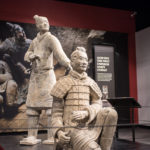The Franklin Institute’s latest exhibit explores a historic archaeological discovery
Terracotta Warriors explores the science and technology used to build, bury, and excavate the Terracotta Army
The Franklin Institute has a new exhibit that is worth viewing this winter—the only east coast engagement of a two-city exhibit tour. Earlier this month, I took my kids and a friend to check it out.
In 1974, a farmer in China was digging a well when he struck upon fragments of terracotta. Buried beneath the land were thousands of life-sized statues, constructed over 2,000 years ago—guarding the tomb of China’s first emperor.
Since this discovery, archaeologists have excavated and researched these warriors—uncovering the secrets beneath our feet since 210 BCE. Questions remain about the elaborate tomb, calling scientists to continue to explore.
Ten terracotta figures from the burial complex will appear in the exhibit: a general, an armored officer, a kneeling archer, a standing archer, an armored soldier, a cavalryman, a saddled horse, a charioteer, a civil official, and a kneeling musician.
Over 170 other artifacts from the pre-Qin, Qin, and Han dynasties accompany the figures. These include weapons, jade pieces, bronze bells, ceremonial vessels, gold ornaments, coins, architectural pieces, and ornate bronze chariot replicas.
Incorporating multimedia and interactive elements, Terracotta Warriors tells the story of how a young prince conquered enemies, formed the empire of China, advanced its civilization, and prepared a burial site for his eternal reign.
Terracotta Warriors runs through March 4th, so plan your visit this Winter. https://www.fi.edu/exhibit/terracotta-warriors
Image: The Franklin Institute

